Why a High-Quality Web Site is an Absolute Must!
More and more people are turning to the internet to get information on the products and services they need. Web sites are becoming the most important touchpoint you can have with potential customers. Your site should not just measure up to the competition’s, it should be a well-organized, information-packed, lead-generating machine.
13 things you need to know to make your site more effective.
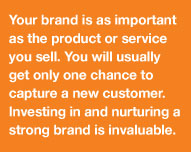 1. First Impressions – Your Brand
1. First Impressions – Your Brand
Potential clients form their initial opinion of a company based on its web site. A professional look, relevant content and ease of use are essential. Is the site up-to-date with the latest news and info? Is the company attentive to detail? Poor grammar, typos and broken links give a bad impression that is hard to overcome. Is the company up to my standards? If it’s not they are gone in 10 seconds or LESS. Only when a prospect forms a favorable first impression of a site will they go on to evaluate the company’s offerings. This is where your branding, strategy, design and USP reel them in.
2. Offline and Online Marketing
All of your print ads, direct mail pieces and promotions should be driving prospects to your site. They should contain a compelling Call-to-Action directing them to your site for more details, etc. You should go a step further by using a unique web address or landing page for each marketing campaign. It helps you measure the effectiveness of each effort and actually raises success rates for campaigns. Techniques like this will help you refine your marketing efforts, making them more profitable.
3. Relevance
Now that your offline marketing is driving qualified prospects to your site, your core message and content must be seen, found relevant and remembered! You know from your own research on the web that you’ll probably visit several sites to gather information, but there’s always that one that you keep going back to that seems to address all your questions in a well organized and attractive manner. That’s the kind of site you want to have.
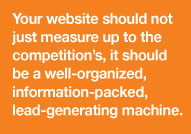 4. Lead Generation
4. Lead Generation
Determine who the primary visitor to your web site is and make sure they can quickly and easily get what they want. When a consumer goes to your site you want them to take action. This may include signing up for a free newsletter, a consultation, registering for an event, requesting a brochure or inquiring about a purchase itself. A well written and designed web site will help elicit these actions and is a necessary step to convert someone from a web site visitor into an actual customer. Talk to your sales force. Find out what your prospect’s typical preliminary questions and obstacles to buying are. Your site should address these up front to help pre-qualify leads and convert visitors into buyers. Raising your conversion rate from just 1 to 2 percent is the same as doubling your web site traffic, and it is usually much easier and cheaper to do.
 5. Don’t just Regurgitate your Brochure onto the Web
5. Don’t just Regurgitate your Brochure onto the Web
Visitors will expect a greater benefit if they take the time to check out your web site. A good web site uses compelling and succinct text, interactively, intuitive navigation systems, etc. Everything on a landing page must be designed and written to entice a visitor to click. Using active words such as “Learn”, “Ask”, “Browse”, “Sign up” encourages your visitor to explore your site. Use “you” and “your” to keep your focus on the prospects needs; avoid “we” and “our”. Keep copy short and use descriptive links to pages that have more information. Remember, you just want to engage them so they make that first click and start exploring what you have to offer.
People read text on web sites very differently than they do text on a page. In fact they rarely read at all, they scan. Studies have shown that people pay the most attention to headlines and subheads when viewing a web site. So make sure these two important pieces of your copy engage visitors. Bullet points and photo captions are also popular with scanners so pay special attention to them as well.
Include keywords your prospects are likely to use in internet searches right in the headline and page title and put the keyword as close to the beginning of the headline as you can. By doing this you assure visitors that they are on a relevant site. It also favorably effects your site’s search engine ranking.
Try not to sound like an ad. Highlight benefits rather than features. Talk about how your product solves problems and make an emotional connection with the prospect. Make your headlines easy to read. For example, instead of “Brand X delivers unprecedented storage density, industry-leading scalability and unrivaled performance!” try “Three easy steps to truly secure data!” By testing different headlines and tracking results you will see which ones lead to actual sales and which ones cause people to leave your site without making an inquiry or purchase.
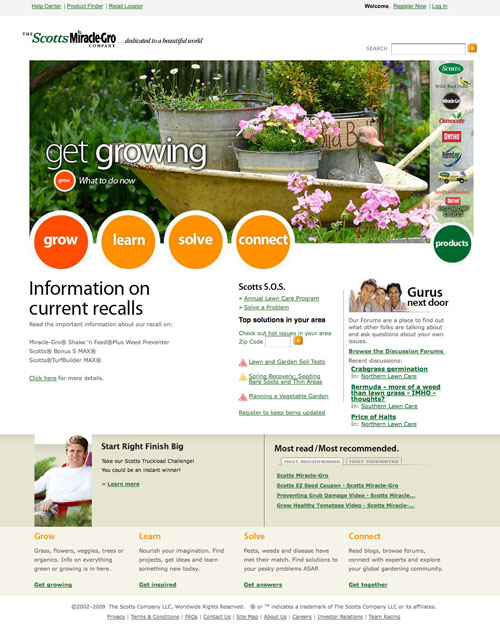 6. Images are Great but don’t forget the Web site Copy
6. Images are Great but don’t forget the Web site Copy
Many businesses put too much emphasis on their web site’s graphics and fancy Flash animations, but then don’t have enough text to back it up. Although on an initial visit people will just scan headlines and subheads, when they find a site they like, informative text will assure them of your competence and provides excellent content for search engines to evaluate when ranking a site (see Search Engine Marketing). You want your graphics to capture their interest, then your copy must satisfy their need to know. If you anticipate and answer the questions and concerns they have you will earn their trust and loyalty. Think like a prospect and ask yourself, “What would I need to know if I were in the market for this product or service”? Thinking this way will change the way you write and organize your content. The Scotts Company improved their web site by changing the entire way it was organized. The previous version was organized around Scotts corporate structure and various divisions within it. Not very user friendly for someone looking for a product to help them grow better tomatoes. The new site is designed with the customer in mind. It’s vibrant, inviting and informative, a resource customers will return to again and again for their gardening needs.
There are other good ways to add relevant, reassuring content to your site. To highlight the benefits of your product or service, consider adding case studies to your site describing how a customer was able to solve a problem or overcome challenges by using your company. Try adding a “Frequently Asked Questions” page. These FAQ pages can be a great marketing tool. Use them to address the questions you think customers might or should ask about your industry. Answering questions they haven’t even thought of yet will make you a resource in their eyes instead of just another vendor.
Writing articles and white papers related to your business and publishing them on your site can put you in the enviable situation of being perceived as an authority. It’s also a way to add relevant content to your site on a regular basis. Consider asking visitors for their email address in return for access to these articles. If you don’t want to require registration for free downloads like white papers, try sending an automated thank-you email with a sign-up form offering future articles, updates and special offers. These are great ways to grow your email list.
Using these content-heavy techniques will help differentiate you from other competing sites. As visitors go about their research, they will look for information on issues, benefits, and features that they first learned about on your site. If a competitor’s site doesn’t sufficiently cover these topics, you will have gained an important edge.
7. Fear of Fraud
Security experts say using your credit card online poses no greater risk of fraud than using it at a store or restaurant. But customers’ fear of fraud on the internet is real and still needs to be addressed. These fears can be countered by placing third-party assurances such as “VeriSign secured” or “BizRate.com customer certified” on your site. This gives prospects the confidence to make a purchase. Testimonials from previous buyers also help to alleviate these fears of fraud.
8. We’re All a Little Lazy
Most people won’t scroll down your web page to find what they are looking for, so your most important content must be “above the fold”.
You should also be sure to keep any registration forms short. Limit your fields to the six or seven most important questions and don’t require too much personal information like phone numbers. Including an e-mail privacy statement link on your forms reassures people that you won’t share their information with spammers, making them more likely to opt in.
9. Stay in Touch with Newsletters and Blogs
Newsletters
Visitor conversions don’t always happen immediately. Keep your visitors coming back by offering an email newsletter or special promotion sign-up on your landing page. If customers like your site or products enough to opt-in to these regular communications they are telling you they are a good prospect. A newsletter is a great vehicle for staying connected and continuing customer interest. Some suggestions for making newsletters engaging include:
• Offering subscriber-only discounts during slow periods for your business.
• Having an industry expert be a “Guest Author” for an article.
• Partnering up with a complementary product or service that does not directly compete with you but shares the same target audience.
• Sharing information that only you have; white papers, FAQs, case studies, survey results or other special data that
may interest your customer and keep them coming back to your site.
Blogs
Blogs have begun to reshape the internet by enabling millions of people to have a voice and share their ideas and opinions with others.
__________________________________________
Wikipedia Definition:
A blog is a type of web site where entries are made much like a journal or diary, then they are displayed in reverse chronological order. Blogs often provide commentary or news on a particular subject, such as food, politics, or local news…A typical blog combines text, images and links to other blogs, web pages, and other media related to its topic.
__________________________________________
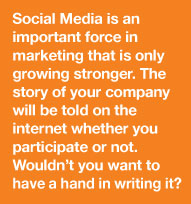 Hosting a blog on your site is a great way to add fresh content, position yourself as an industry expert and keep in touch with prospects. Think of a blog as an online, interactive newsletter for your company. RSS syndication allows visitors to subscribe to your blog and receive updates immediately after you post a new article. Blog hosting services make it easy to create a blog right from your browser window. Companies can post their latest articles, press releases, announcements, and have them instantly available to interested parties. They can also use a blog to get customer’s opinions and ideas for bettering their product or service.
Hosting a blog on your site is a great way to add fresh content, position yourself as an industry expert and keep in touch with prospects. Think of a blog as an online, interactive newsletter for your company. RSS syndication allows visitors to subscribe to your blog and receive updates immediately after you post a new article. Blog hosting services make it easy to create a blog right from your browser window. Companies can post their latest articles, press releases, announcements, and have them instantly available to interested parties. They can also use a blog to get customer’s opinions and ideas for bettering their product or service.
Blogs are interactive because users can link to your blog posts, giving you a great source of incoming links that will raise your site’s page rank. They also allow users to post comments about your content. You can choose whether or not you want to allow these comments and you can delete any you find objectionable. Many companies are afraid of getting negative feedback but it’s a great way to find out what your customers really think. If you address negative feedback in a positive, problem-solving manner, you can gain the trust and loyalty of readers. This kind of service can differentiate you from your competitors and potential customers may see it as a real plus.
Staying in touch with current customers and prospects with various offers, news, articles and discounts will help you build a relationship with them that will lead to more sales.
10. Search Engine Marketing…Increase your Visibility
When people look for information on the internet, and that’s where they are looking today, they usually start by entering a topic or keyword into a search engine like Yahoo™ or Google™. You’ll want your site to be in the top results of that search. This is achieved through a process called Search Engine Marketing (SEM).
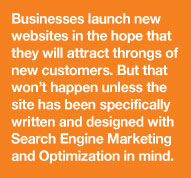 SEM is the practice of setting up and running a successful online presence while gaining maximum search engine visibility, i.e. the position of your site in the search engine results for certain keywords or phrases people enter when looking for information on products and services. Everything depends on how deep you are listed in these results. If you appear on the first couple of pages of results it’s very likely this visibility will bring a lot of traffic. If you are the 556th result it’s likely that people will stumble across you only by accident.
SEM is the practice of setting up and running a successful online presence while gaining maximum search engine visibility, i.e. the position of your site in the search engine results for certain keywords or phrases people enter when looking for information on products and services. Everything depends on how deep you are listed in these results. If you appear on the first couple of pages of results it’s very likely this visibility will bring a lot of traffic. If you are the 556th result it’s likely that people will stumble across you only by accident.
SEM programs usually consist of three main strategies: Search Engine Optimization, Paid Inclusion/Paid Advertising and Web Analytics.
Search Engine Optimization (SEO) is both art and science. By changing the content, HTML code and structure of your site SEO experts make your pages more compatible with the robots (spiders) search engines will send to read and rank them. The content of your web site and the way keywords are used in it determine whether or not the search robots will consider your content relevant and not just spam.
Paid Inclusion is different. You pay the search engine and it guarantees the inclusion of your site in the index. Many search engines also offer advanced pay-for-performance programs like the “sponsored results” that you often see at the top of your results page, and ads next to the organic results (pay-per-click ads) the most well known of these are GoogleAds.
A very important part of any SEM program is Web Analytics – tracking and analyzing visitor behavior on your site. You can find out the bounce rate for your landing pages – people who arrive at your landing page but leave almost immediately. By analyzing this data over time you’ll learn what’s working and what isn’t. Use this information to make improvements and raise traffic and conversion rates so that your site becomes a money maker, not just a business expense. Most web site hosting companies offer these analytics programs as an upgrade to your hosting plan; take advantage of them. Google™ Analytics is also a great way to track your site’s visitors and discover what keywords are working best for you.
See the section titled: Search Engine Marketing and Search Engine Optimization… Don’t Leave Home without Them for more information on this very important topic.
11. Automated Emails
Don’t miss out on a possible good prospect. Use auto-responders to trigger an automatic email message for people who came to your site but didn’t buy, abandoned a shopping cart, downloaded a white paper or filled out a survey. Contacting them when your site is still fresh in their mind, with content specific to their area of interest, may convert them into customers.
12. Multiple Landing Pages or Squeeze Pages
When people are coming to your site you want them to immediately see what is relevant to their needs. Creating specific landing pages for every ad, paid search term, direct mailer or email campaign you conduct will lead to more sales. Many campaigns fail to convert visitors into customers because they send them to an overly general landing page which does not meet the customer’s expectations of relevancy. Although unique to your campaign, your landing pages should include some branding elements and helpful navigation to explore the rest of your site so visitors will still understand who you are and what else you have to offer.
13. Set up a Follow-Up Program to Act on Leads and Track Web site Performance
Once you’ve developed your lead-generating web site you’ll need a systematic way to follow up on these prospects. You can start with auto-respond emails to any inquiries letting prospects know that you received their inquiry and will be following up appropriately. There are lead capture programs than can import information gathered from forms on your web site and add them to your database. Assign someone to either follow up on these new leads in a timely fashion or distribute them to your sales force. But don’t let those leads get stale.
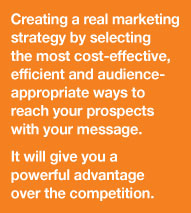 Conclusion
Conclusion
Your company’s web site is a critical aspect of the overall impression a prospect forms about your company. You not only need to be online but you also need to be doing the right things online for the right reasons; in other words – strategy. A well planned site with relevant content can outperform its deep-pocketed rivals who are less focused and savvy with their online presence. That’s a competitive advantage you can’t pass up.






